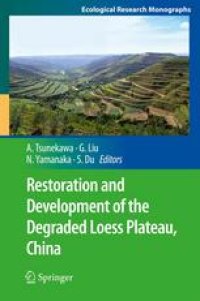
Ebook: Restoration and Development of the Degraded Loess Plateau, China
- Tags: Environmental Management, Soil Science & Conservation, Nature Conservation, Environment general
- Series: Ecological Research Monographs
- Year: 2014
- Publisher: Springer Japan
- Edition: 1
- Language: English
- pdf
This book presents state-of-the-art scientific evidence and technological innovations to restore lands on the Loess Plateau of China, known worldwide for its serious land degradation and desertification problems. Supported by a rapidly developing Chinese economy and the dissemination of effective technology, the Grain-for-Green Project and Western Development Action launched by the Chinese government have resulted in successful ecological restoration and protection over the past 30 years. These programs have contributed not only to conservation of soil and water, but also to economic development. At the same time, however, these developmental interventions have brought new challenges that have not yet been fully addressed. The book describes (1) case studies of success and failure in practice, including rare success stories of combating desertification; (2) technical issues such as erosion control and breeding of stress-tolerant plant species, and socioeconomic measures taken by the Chinese government and lending policies with support from the World Bank; and (3) comprehensive measures against desertification, such as water and wind erosion, salinization, and deforestation. This volume is recommended for researchers and students above the undergraduate level in diverse fields including soil science, rural engineering, social technology and civil engineering, biology, ecology, climatology, physical and human geography, and developmental economics, among others. It also serves as a valuable resource for engineers, government officials, and NPOs and NGOs involved in afforestation, ecological restoration, combating desertification, disaster prevention, and sustainable rural development.
This book presents state-of-the-art scientific evidence and technological innovations to restore lands on the Loess Plateau of China, known worldwide for its serious land degradation and desertification problems. Supported by a rapidly developing Chinese economy and the dissemination of effective technology, the Grain-for-Green Project and Western Development Action launched by the Chinese government have resulted in successful ecological restoration and protection over the past 30 years. These programs have contributed not only to conservation of soil and water, but also to economic development. At the same time, however, these developmental interventions have brought new challenges that have not yet been fully addressed. The book describes (1) case studies of success and failure in practice, including rare success stories of combating desertification; (2) technical issues such as erosion control and breeding of stress-tolerant plant species, and socioeconomic measures taken by the Chinese government and lending policies with support from the World Bank; and (3) comprehensive measures against desertification, such as water and wind erosion, salinization, and deforestation. This volume is recommended for researchers and students above the undergraduate level in diverse fields including soil science, rural engineering, social technology and civil engineering, biology, ecology, climatology, physical and human geography, and developmental economics, among others. It also serves as a valuable resource for engineers, government officials, and NPOs and NGOs involved in afforestation, ecological restoration, combating desertification, disaster prevention, and sustainable rural development.
This book presents state-of-the-art scientific evidence and technological innovations to restore lands on the Loess Plateau of China, known worldwide for its serious land degradation and desertification problems. Supported by a rapidly developing Chinese economy and the dissemination of effective technology, the Grain-for-Green Project and Western Development Action launched by the Chinese government have resulted in successful ecological restoration and protection over the past 30 years. These programs have contributed not only to conservation of soil and water, but also to economic development. At the same time, however, these developmental interventions have brought new challenges that have not yet been fully addressed. The book describes (1) case studies of success and failure in practice, including rare success stories of combating desertification; (2) technical issues such as erosion control and breeding of stress-tolerant plant species, and socioeconomic measures taken by the Chinese government and lending policies with support from the World Bank; and (3) comprehensive measures against desertification, such as water and wind erosion, salinization, and deforestation. This volume is recommended for researchers and students above the undergraduate level in diverse fields including soil science, rural engineering, social technology and civil engineering, biology, ecology, climatology, physical and human geography, and developmental economics, among others. It also serves as a valuable resource for engineers, government officials, and NPOs and NGOs involved in afforestation, ecological restoration, combating desertification, disaster prevention, and sustainable rural development.
Content:
Front Matter....Pages i-xviii
Front Matter....Pages 1-1
Location, Geology and Landforms of the Loess Plateau....Pages 3-21
Climate of the Loess Plateau....Pages 23-33
Soils on the Loess Plateau....Pages 35-47
Vegetation of the Loess Plateau....Pages 49-60
Agriculture on the Loess Plateau....Pages 61-74
Front Matter....Pages 75-75
Soil Erosion in the Loess Plateau Region of China....Pages 77-92
Irrigated Agriculture and Salinization....Pages 93-110
Land Use Change and Deforestation on the Loess Plateau....Pages 111-120
Front Matter....Pages 121-121
Comprehensive Chinese Government Policies to Combat Desertification....Pages 123-135
Grain-for-Green Policy and Its Achievements....Pages 137-147
Poverty Alleviation Projects Through Integrated Ecological Management Supported by the World Bank: Case Study of the Yanhe River Basin....Pages 149-160
Policies and Measures of Chinese Local Government on Grain-for-Green Policy and Desertification Control....Pages 161-172
Front Matter....Pages 173-173
Monitoring Regional Desertification....Pages 175-182
Countermeasures to Prevent Water Erosion in the Loess Plateau of China....Pages 183-198
Secondary Salinization and Its Countermeasures....Pages 199-213
Enhancing Drought Resistance of Plants Using Wheat as a Test Crop....Pages 215-231
Vegetation Restoration on Loess Plateau....Pages 233-251
Front Matter....Pages 253-253
Recent Changes on the Loess Plateau: Land Resource Development and Rapid Urbanization....Pages 255-265
Future Development-Related Challenges on the Loess Plateau....Pages 267-282
Back Matter....Pages 283-288